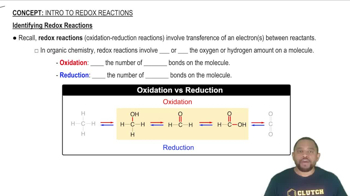(b) Use the energy requirements of these two pro- cesses to explain why photodissociation of oxygen is more important than photoionization of oxygen at altitudes below about 90 km.
Ch.18 - Chemistry of the Environment

Brown15th EditionChemistry: The Central ScienceISBN: 9780137542970Not the one you use?Change textbook
Chapter 18, Problem 21
Do the reactions involved in ozone depletion involve changes in the oxidation state of the O atoms? Explain.
 Verified step by step guidance
Verified step by step guidance1
Step 1: Understand the basic chemistry of ozone (O₃) in the stratosphere. Ozone is a molecule composed of three oxygen atoms and plays a crucial role in absorbing harmful ultraviolet radiation from the sun.
Step 2: Identify the key reactions involved in ozone depletion. The primary reactions involve the interaction of ozone with chlorine and bromine compounds, which are often released from chlorofluorocarbons (CFCs) and halons.
Step 3: Examine the reaction mechanism. A typical reaction involves a chlorine atom (Cl) reacting with an ozone molecule (O₃) to form chlorine monoxide (ClO) and oxygen (O₂). The ClO can further react with another ozone molecule to regenerate the chlorine atom and produce more oxygen.
Step 4: Analyze the oxidation states of oxygen in these reactions. In ozone (O₃), the oxidation state of each oxygen atom is 0. When ozone decomposes into molecular oxygen (O₂), the oxidation state of oxygen remains 0. Therefore, there is no change in the oxidation state of oxygen atoms during these reactions.
Step 5: Conclude that while ozone depletion involves chemical reactions, the oxidation state of oxygen atoms does not change. The process is more about the conversion between different forms of oxygen (O₃ to O₂) rather than a change in oxidation state.
Key Concepts
Here are the essential concepts you must grasp in order to answer the question correctly.
Ozone Depletion
Ozone depletion refers to the reduction of ozone (O3) in the stratosphere, primarily caused by human-made chemicals like chlorofluorocarbons (CFCs). These substances release chlorine atoms upon exposure to ultraviolet (UV) radiation, which catalyze the breakdown of ozone molecules into oxygen (O2), leading to a thinner ozone layer that allows more UV radiation to reach the Earth's surface.
Recommended video:
Guided course

Formation Equations Example 1
Oxidation State
The oxidation state, or oxidation number, is a measure of the degree of oxidation of an atom in a chemical compound. It indicates the number of electrons an atom has gained, lost, or shared when forming a compound. In the context of ozone depletion, understanding the oxidation states of oxygen in O3 and O2 is crucial to analyze the chemical transformations occurring during the reactions.
Recommended video:
Guided course

Oxidation Numbers
Redox Reactions
Redox reactions, or reduction-oxidation reactions, involve the transfer of electrons between species, resulting in changes in their oxidation states. In the case of ozone depletion, the reactions can be classified as redox processes where chlorine atoms are reduced (gaining electrons) while ozone is oxidized (losing electrons), leading to a change in the oxidation states of the involved oxygen atoms.
Recommended video:
Guided course

Identifying Redox Reactions
Related Practice
Textbook Question
1
views
Textbook Question
The wavelength at which the O2 molecule most strongly absorbs light is approximately 145 nm. (a) In which region of the electromagnetic spectrum does this light fall?
2
views
Textbook Question
The ultraviolet spectrum can be divided into three regions based on wavelength: UV-A (315–400 nm), UV-B (280–315 nm), and UV-C (100–280 nm). (b) In the absence of ozone, which of these three regions, if any, are absorbed by the atmo- sphere?
3
views
Textbook Question
Which of the following reactions in the stratosphere cause an increase in temperature there? (a) O(g) + O2(g) → O3+(g) (b) O3*(g) + M(g) → O3(g) + M*(g) (c) O2(g) + hv → 2 O(g) (d) O(g) + N2(g) → NO(g) + N(g) (e) All of the above
1
views
Textbook Question
(a) What is the difference between chlorofluorocarbons and hydrofluorocarbons?
